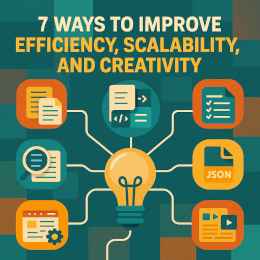5 Fresh AI Trends Transforming Everyday Productivity
Published 5 October 2025

Introduction
The pace of change in technology has never been faster. Artificial Intelligence is now an invisible hand shaping nearly every digital experience, from email summaries to image editing and search. What was once a futuristic dream is now the engine of modern creativity and decision-making. But to benefit fully, individuals must learn to adapt their thinking—embracing AI not as a replacement, but as a powerful collaborator.
Traditional tools relied on direct input and predictable output. In contrast, today’s AI tools interpret language, context, and intent—producing results that feel intuitive. This shift means that users must develop new habits, combining curiosity, structure, and experimentation to unlock the true potential of AI-enhanced workflows. This evolution echoes the leadership transformation explored in Evolving Landscape of Leadership: Adapting to the Age of AI, where human adaptability and digital fluency are becoming inseparable skills.
In this article, we explore five distinct but connected trends showing how AI is evolving from a reactive tool into a proactive, creative partner. Each trend includes a discussion, real-world tools, and a practical next step so readers can begin applying these ideas immediately.
1) Agentic Workflows (AI Orchestration)
The gist: Instead of one prompt → one reply, multiple small AIs act like a team: one drafts, one critiques, one packages.
Why it matters: It imitates a well-run workflow, so output quality improves while time-to-finish shrinks.
- Everyday example: One AI outlines an article; a second AI fact-checks key claims; a third AI formats the final draft as HTML.
- Pro tip: Use short, clear roles (e.g.,
Critic
,Summariser
,Formatter
) and chain them.
Discussion: Agentic workflows represent a new layer of automation where AI tools communicate and coordinate like a team of specialists. Imagine an editor who drafts, a reviewer who critiques, and a designer who formats—all working instantly, in sequence, and without friction. Tools such as LangChain, AutoGPT, and OpenAI function calling make this coordination possible. This approach saves mental energy while producing consistent results. For creators, it transforms complex, multi-step tasks into an automated relay of intelligence. The key lies in defining clear roles and responsibilities for each agent and allowing them to operate semi-independently. Businesses are already using this pattern to manage document review, code analysis, and marketing. For individuals, it’s a way to structure creative chaos into efficient collaboration.
Next Step: Try assigning three AI prompts distinct roles in a single project and observe how their cooperation improves your results.
2) Retrieval–Augmented Generation (RAG)
The gist: Feed your own notes, documents, and pages into the AI so it answers with your context, not just the public web.
Why it matters: You get specific, sourceable answers drawn from your material—less generic fluff, more relevance.
- Everyday example: Ask an AI to
summarise the last ten meeting notes & list action items
from your files. - Pro tip: Keep documents cleanly titled and dated so retrieval stays accurate.
Discussion: RAG bridges the gap between personal knowledge and general AI reasoning. It works by injecting your own data—notes, documents, reports—into the AI’s reasoning process, giving it both memory and context. Instead of vague or irrelevant replies, it references your exact content. Tools like Pinecone, FAISS, and ChatGPT’s Custom GPTs now make RAG accessible even to individual creators. This makes it especially useful for professionals managing large knowledge bases or researchers seeking precision. The challenge is organisation: clean filenames, structured folders, and dated documents make RAG perform at its best. The reward is faster retrieval, smarter insights, and drastically reduced time spent searching.
Warning: Always check that an app’s privacy and data settings match your own expectations for security and personal information protection.
Next Step: Gather five of your key documents and experiment with AI tools that allow custom uploads or private data references.
3) AI–Generated Metadata & Auto–Tagging
The gist: Let AI create structured tags, captions, alt text, and SEO snippets the moment you make new content.
Why it matters: Searchability improves, archives stay tidy, and accessibility gets better with almost no extra work.
- Everyday example: Drop a photo and get filename suggestions, keywords, a one-line caption, and safe
alttext. - Pro tip: Store metadata next to the file (e.g.,
.json) so it travels with your content.
Discussion: Metadata is the invisible language that connects your work to the world. Without it, search engines and databases struggle to understand your files. AI now makes it effortless to generate high-quality metadata at scale. Whether it’s writing alt text for accessibility or creating SEO-friendly summaries, AI ensures every file carries useful context. Services like Google Vertex AI, Microsoft Copilot, and OpenAI Embeddings can automate this at creation time. For creators, it removes tedious tagging work and helps maintain order in archives. For publishers, it boosts discoverability while maintaining consistency. This concept aligns closely with 7 Ways Microsites Can Boost Efficiency, Scalability, and Creativity, where structure and automation combine to enhance visibility and workflow.
Next Step: Use an AI tool to generate descriptive tags for one of your folders and review how it improves your search results.
4) Multimodal Inputs & Outputs
The gist: AI can read images, audio, or video—and then output text, images, or audio in return.
Why it matters: One capture session turns into many formats: transcript, summary, captions, highlights, and more.
- Everyday example: Record a voice memo; get a clean summary, pull-quotes, and a to-do list.
- Pro tip: Pair short clips with specific asks like
extract decisions & deadlines
for best results.
Discussion: Multimodal AI understands the world more like humans do—through multiple senses. Instead of text-only input, you can now show an image, upload an audio file, or share a short clip, and receive structured insights in seconds. Models like GPT-4o, Gemini, and Claude 3 are redefining multimodal understanding. This trend is revolutionising creative production, journalism, and education. A teacher can record a lecture and get instant summaries and questions. A designer can upload a sketch and get layout suggestions. The real power lies in translation between modes—turning sound into words, visuals into ideas, or vice versa. As hardware and bandwidth improve, multimodal interaction will become standard, making AI assistants truly perceptive partners in work and learning.
Next Step: Try uploading a short image or voice clip into a multimodal AI model and explore how it interprets your input.
5) Continuous Assistants (Quiet, In-the-Background AI)
The gist: Small, scheduled AI jobs run unattended—nudging you with digests and changes, not waiting for prompts.
Why it matters: You move from reactive to proactive: less friction, more flow.
- Everyday example: Nightly email & notes digest; weekly
what changed
report across your documents. - Pro tip: Start with low-risk summaries before automating any approvals or publishing steps.
Discussion: Continuous AI assistants represent the next leap in convenience—software that quietly works while you rest. These systems scan your digital environment for updates, trends, and tasks, then produce concise digests or alerts. Platforms like Zapier, Make.com, and Notion AI Automations make this concept accessible. For professionals juggling many projects, this background intelligence creates breathing space—reducing mental load and ensuring nothing critical slips by. It’s the digital equivalent of a diligent assistant who anticipates needs and reports back with calm precision. Privacy and transparency remain key, but the potential for calm, informed productivity is immense.
Next Step: Set up one automated AI summary—such as a daily notes digest or project status email—and build from there.
Conclusion
These five trends mark the transition from reactive AI tools to proactive, context-aware collaborators. They’re practical, human-centered, and accessible to everyone—from freelancers and students to large organisations. Agentic workflows amplify teamwork, RAG makes AI personal, metadata automation boosts visibility, multimodality expands communication, and continuous assistants restore focus.
The real transformation happens when you connect these elements into your daily rhythm. AI can’t replace curiosity or judgment, but it can remove friction, reveal insight, and multiply output. By experimenting with one or two of these trends, readers can begin shaping their own intelligent workflows—turning technology into an everyday ally. Always remember to review the privacy settings of any AI system before uploading personal data or proprietary content to ensure transparency and trust.
See Also
- Evolving Landscape of Leadership: Adapting to the Age of AI
- 7 Ways Microsites Can Boost Efficiency, Scalability, and Creativity



